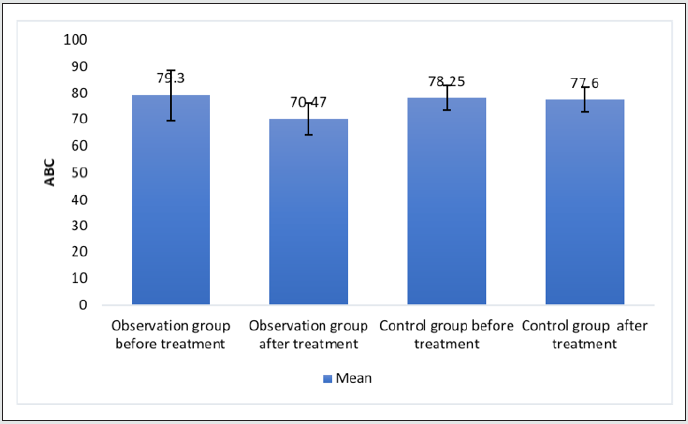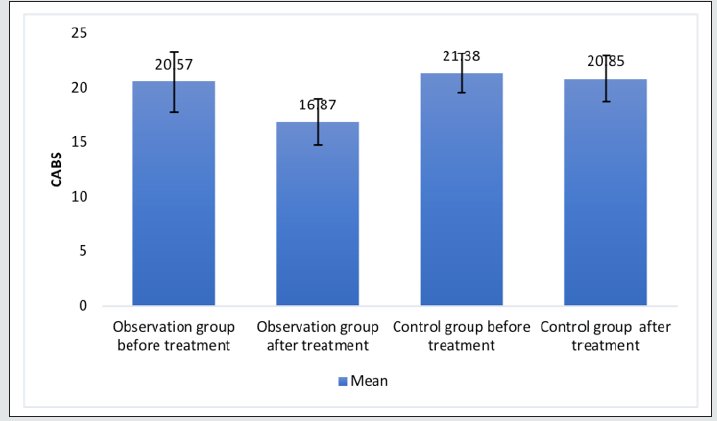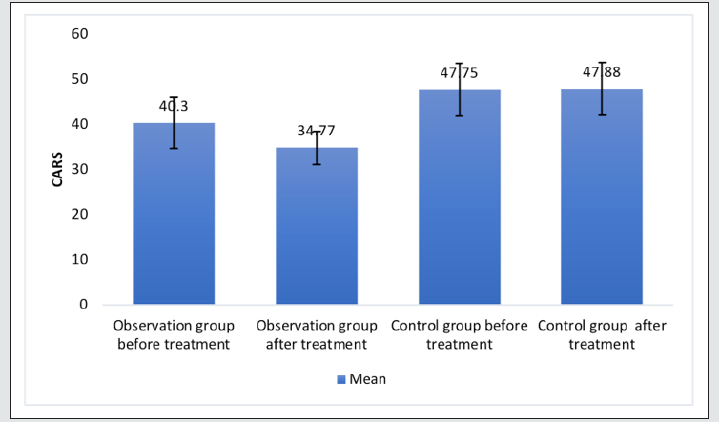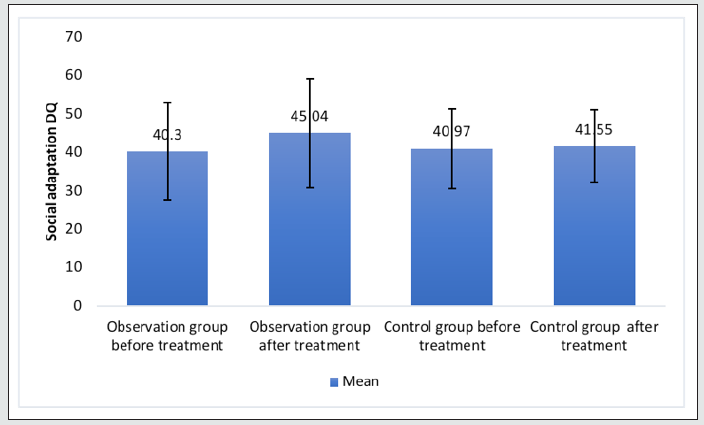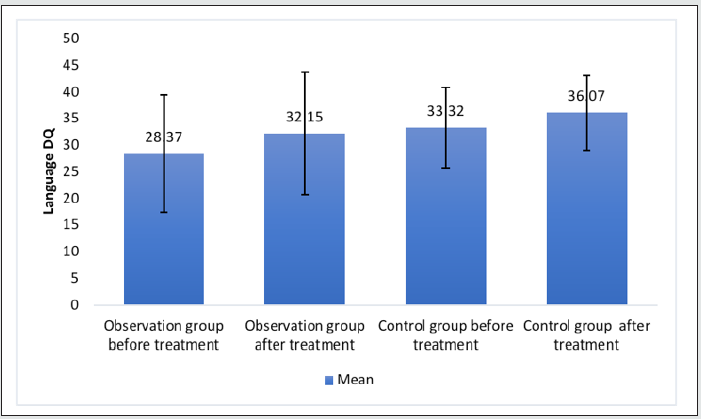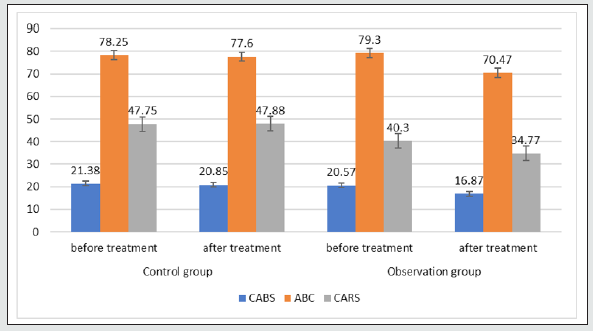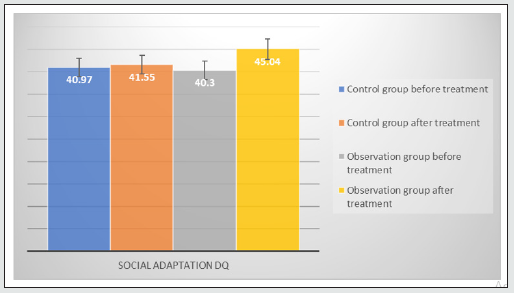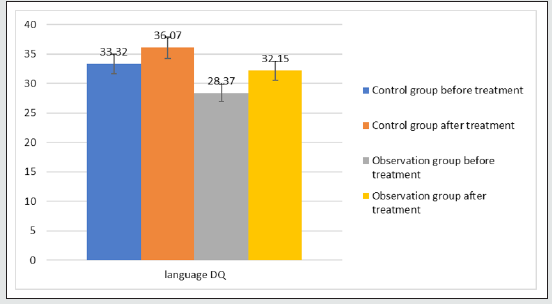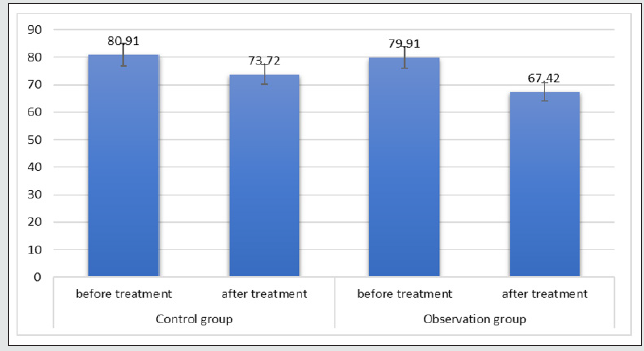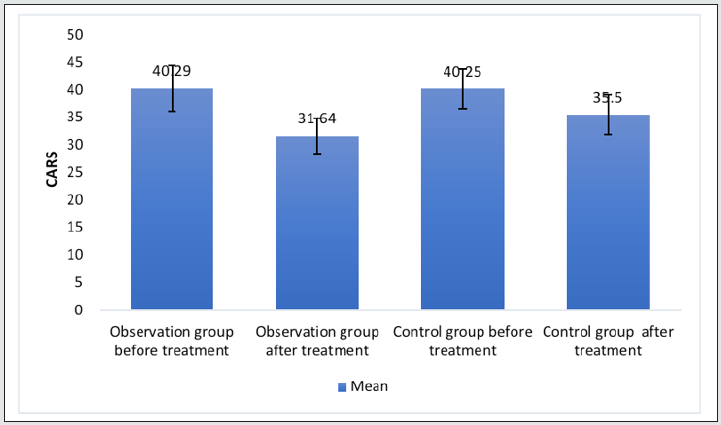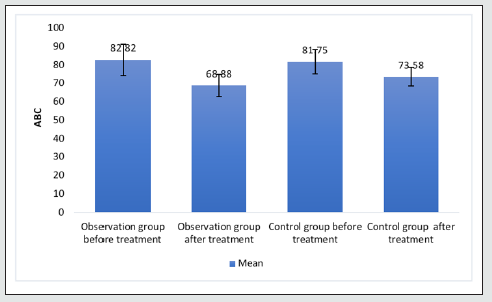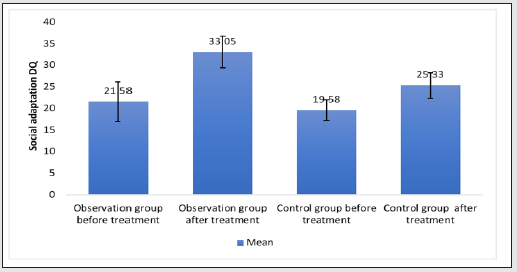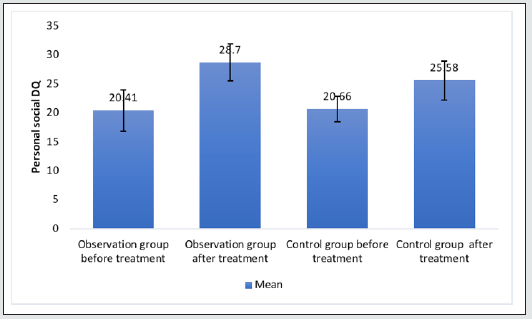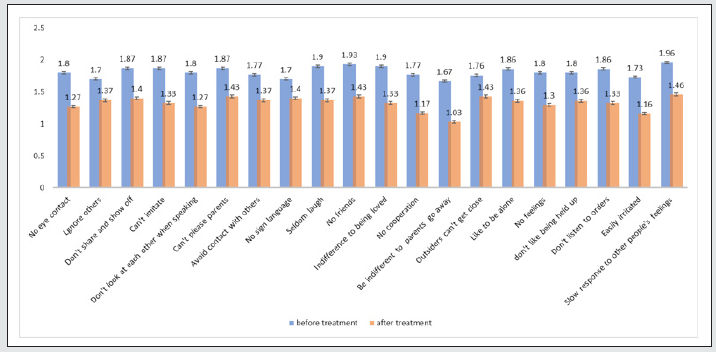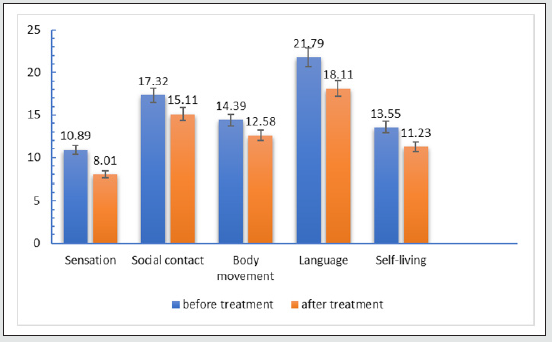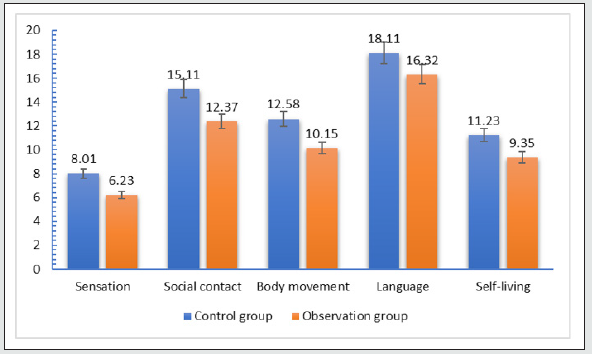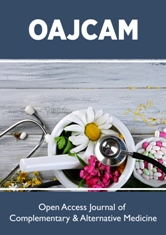
Lupine Publishers Group
Lupine Publishers
Menu
ISSN: 2644-1217
Review ArticleOpen Access
Acupuncture for Autism Spectrum Disorders Volume 3 - Issue 3
Zhenhuan Liu*, Bingxu Jin and Yong Zhao
Nanhai Maternity and Child Hospital, Guangzhou University of Chinese Medicine, China
Received:July 07, 2021 Published:August 13, 2021
*Corresponding author:Zhenhuan Liu, Nanhai Maternity and Child Hospital Affiliated to Guangzhou University of Chinese Medicine, Guangzhou, Guangdong Province, China
DOI: 10.32474/OAJCAM.2021.03.000162
Abstract
Autism spectrum disorders (ASD), a severe and pervasive heterogeneous neurodevelopment disorder, is characterized by impaired social interaction and communication, repetitive behavioral patterns, and restricted interests. Many aspects of ASD are still debatable, with elusive and complex etiologies, and no effective therapy exists. At present, many studies have verified the effectiveness and safety of acupuncture in the treatment of autism. However, the results should be explained cautiously due to methodological weakness. In order to obtain powerful evidence of the effectiveness and safety of acupuncture in the treatment of ASD, it is worth designing a study with higher methodological quality. We summarize the potential mechanism of acupuncture in the treatment of ASD. We found the mechanism of acupuncture treatment of ASD is still unclear. On the one hand, due to the complex etiology and biochemical changes of ASD, it is a neurodevelopmental disorder syndrome with a variety of biological factors. On the other hand, there are few basic research on the mechanism of acupuncture in the treatment of ASD. There is still a long way to go to reveal the secret of this mechanism. Acupuncture has a short history in the treatment of autism, but the application of scalp points has achieved remarkable curative effect. There are different kinds of scalp acupuncture therapy in clinic. Thus, we put forward “Xingnao Kaiqiao scalp acupuncture therapy”and bring forth the need for well-designed, rigorous clinical and experimental studies to provide formidable scientific evidence validating the efficacy and safety of acupuncture in the treatment of ASD.
Keywords:Acupuncture; Autism spectrum disorders; Xingnao Kaiqiao scalp acupuncture therapy
Abbreviations:ASD: Autism Spectrum Disorders; WHO: World Health Organization; BEI: Behavioral and Educational Interventions; CAM: Complementary and Alternative Medicine; CABS: Clancy Autism Behavior Scale; CARS: Children’s Autism Rating Scale; ABC: Autism Children’s Behavior Scale; ATEC: Autism Treatment Evaluation Checklist; PSD-95: Postsynaptic Density Protein 95
Introduction
Autism spectrum disorders (ASD), a severe and pervasive heterogeneous neurodevelopment disorder [1], is characterized by impaired social interaction and communication, repetitive behavioral patterns, and restricted interests [2]. The prognosis of ASD was poor, and most of them were accompanied by mental retardation. The impairments of ASD can have a severe impact on learning and social functioning that may persist into adulthood. Studies have shown that the more severe the severity of ASD, the lower the intelligence level, the more serious the damage of quality of life [3]. Other studies have shown that ASD children have an impact on their parents’ quality of life. The quality of life of parents is negatively correlated with the condition of children with ASD, but positively correlated with their intelligence level [4]. ASD have an estimated prevalence of 3.3 to 116 children per 10,000 [5,6]. The ratio of male to female was 4.67:1 [7]. According to the World Health Organization (WHO), an estimated 1 in 160 children suffer from ASD worldwide, and the prevalence has been rising over the past 50 years [8]. Thus, ASD has become a global public health problem. It is suggested that ASD might result from an interaction between genetic, environmental, and immunological factors, with oxidative stress as a mechanism linking these risk factors [9]. Many aspects of ASD are still debatable, with elusive and complex etiologies, and no effective therapy exists, although there is broad consensus that early intensive intervention is warranted [10]. Although there is no definitive cure for ASD, numerous interventions may improve its symptoms. Treatment modalities for ASD are categorized as behavioral and educational interventions (BEI), psychopharmacologic interventions, or complementary and alternative medicine (CAM) [11]. Treatment with risperidone, a common medication for the treatment of maladaptive behaviors in ASD, exhibits adverse side effects such as weight gain, fatigue, drowsiness, and tremors [12,13]. Previous studies have reported that 74% of children with ASD use 1 or more type(s) of CAM treatments because parents of ASD children perceived CAM interventions as safe and natural [14]. CAM, which includes acupuncture, is increasingly being applied in children with ASD [15]. Acupuncture has been successfully practiced in China for the last 4000 years and is proven to be tolerable for both ASD children and their parents [16]. A previous review of 27 studies and 1736 patients provides evidence for the efficacy and safety of acupuncture in children with ASD [17]. It is very important to explore the efficacy and safety of acupuncture in the treatment of ASD.
Clinical applications of acupuncture for ASD
In order to verify the efficacy and safety of acupuncture in the treatment of ASD, many clinical studies have been conducted. At present, acupuncture treatment of ASD mostly choose scalp acupoints. The therapeutic effect was enhanced by twirling or electroacupuncture. In addition to acupuncture, acupoint catgut embedding can also consolidate the curative effect.
Acupuncture
Liu et al. [18] observed the clinical effect of Yizhi scalp acupuncture on children with autism. Thirty-eight children with autism were treated with scalp acupuncture for 30 times, and electrical stimulation was given for 30 minutes during acupuncture. The results showed that 14 cases were markedly effective, 16 cases were effective, and 8 cases were ineffective. Follow up for 1 to 2 years showed that 14 of the 30 effective cases were gradually recovering, and 9 of them could follow the class. 10 patients had no significant progress, and 6 patients had deterioration. The shortterm effective rate was 78.9%, and the long-term follow-up rate was 36.8%. The difference of cars scores before and after treatment was statistically significant (P < 0.01). There were 16 cases with extensive and severe EEG abnormalities before treatment, and 10 cases recovered to normal after treatment. No adverse reactions were found during the treatment. It can be concluded that scalp acupuncture can significantly improve autistic patients’ extreme loneliness, visual contact disorder, language repetition, obsessivecompulsive consistency and apathy. Liu et al. [19] verified the curative effect of music therapy combined with scalp acupuncture on autistic children. 70 cases of autistic children were divided into observation group (30 cases) and control group (40 cases). The observation group was treated with music therapy combined with scalp acupuncture therapy, while the control group was treated with structured education treatment mode. Music therapy includes RBT music therapy, Nordoff Robbins creative music therapy, Orff music therapy and music listening method. The scalp acupuncture therapy was “invigorating the mind and enlightening the orifices”, and the intelligence nine needles, emotion area and heart and liver area were selected.
A stainless-steel filiform needle with a specification of 0.30mm × 25mm was selected. The angle between the needle and scalp was about 15 ~ 30 ° and the needle was quickly inserted under the scalp. According to different acupoint areas, 15 ~ 25 mm can be punctured, and the needle can be retained for 2 ~ 4 h. In the process of retaining the needle, the needle was run three times, mainly by twisting and twisting technique, with flat reinforcing and reducing. The children without epilepsy were treated with electroacupuncture for 15 minutes each time. Han’s multi-purpose electric therapeutic apparatus was selected as electroacupuncture instrument, and density wave was used. Structured education is taught by senior special education teachers and accompanied by parents. Music therapy and structured education were given once a day, one day off a week, and 60 times as a course of treatment. Before treatment and after 1 course of treatment, the patients were assessed with Clancy autism behavior scale (CABS), children’s Autism Rating Scale (CARS), autism children’s behavior scale (ABC), Gesell development scale (DQ for social adaptation, DQ for personal social interaction, and DQ for language). The results showed that before and after treatment, the scores of “ CABS “, “ABC” and “ CARS “ in the observation group were statistically significant (P < 0.01). That is, after a course of treatment, the scores of the above three scales in the observation group were significantly lower than those before treatment, indicating that the treatment mode of music therapy combined with scalp acupuncture therapy has a significant improvement effect on autism. There was no significant difference in the scores of the three scales before and after treatment in the control group (P > 0.05), suggesting that after a course of treatment, the treatment methods in the control group had no significant effect on reducing the scores of autisms. After treatment, there were significant differences between the observation group and the control group in the “ CABS “ and “ABC” scores, suggesting that the treatment effect of the observation group is better than that of the control group. However, the “cars” score of the observation group and the control group had significant difference before treatment, and the baseline was inconsistent and not comparable. Therefore, there is a significant difference between the two results after treatment, which does not mean that the treatment effect of the observation group is better than that of the control group (Figures 1-3).
The scores of “social adaptation DQ” before and after treatment in the observation group were statistically significant, suggesting that after a course of treatment, the score of “social adaptation DQ” in the observation group was significantly higher than that before treatment (P < 0.01). It shows that music therapy combined with scalp acupuncture therapy has a significant effect on improving the intelligence level of autistic children. There was no significant difference in the scores of “social adaptation DQ” before and after treatment in the control group (P > 0.05), suggesting that after a course of treatment, the score of “social adaptation DQ” in the control group was not significantly higher than that before treatment. The control group had no significant effect on improving the intelligence level of children. There was significant difference between the two groups before and after treatment (P < 0.01), suggesting that the treatment of observation group is better than that of control group in improving children’s intelligence level (Figure 4). There was statistical significance in the comparison of “language DQ” scores between the observation group and the control group before and after treatment, suggesting that after a course of treatment, the “language DQ” score of the observation group and the control group was significantly higher than that before treatment (P < 0.01). The results show that the two methods can improve the language level of autistic children. There was a significant difference between the two groups before and after treatment (P < 0.01), suggesting that the treatment of observation group is better than that of control group in improving children’s language level (Figure 5). It can be concluded that music therapy combined with scalp acupuncture therapy can significantly improve the treatment effect, can better improve the autistic symptoms of children and improve IQ, language ability. There was no mention of safety.
After treatment, the ABC score of the observation group was lower than that before treatment (P < 0.01), and the ABC score of the control group had no significant change (P > 0.05), suggesting that music therapy combined with scalp acupuncture therapy can significantly improve autism, while music therapy has no significant effect on reducing ABC score. The treatment mode of music therapy combined with scalp acupuncture therapy has a significant role in promoting the core symptoms of autism, and its curative effect is better than that of single music therapy. (Cited from Liu ZH et al., Proceedings of the 10th Annual Academic Meeting of China Music Therapy Association : 2011:56-62) After treatment, the CABS score of the observation group was lower than that before treatment (P < 0.01), and the CABS score of the control group had no significant change (P > 0.05), suggesting that music therapy combined with scalp acupuncture therapy can significantly improve autism, while music therapy has no significant effect on reducing CABS score. (Cited from Liu ZH et al., Proceedings of the 10th Annual Academic Meeting of China Music Therapy Association:2011:56-62). After treatment, the CARS score of the observation group was lower than that before treatment (P < 0.01), and the CARS score of the control group had no significant change (P > 0.05), suggesting that music therapy combined with scalp acupuncture therapy can significantly improve autism, while music therapy has no significant effect on reducing CARS score. (Cited from Liu ZH et al., Proceedings of the 10th Annual Academic Meeting of China Music Therapy Association(2011:56-62).
The social adaptation DQ score of the observation group after treatment was higher than that before treatment (P < 0.01), and the social adaptation DQ score of the control group after treatment had no significant change (P > 0.05), suggesting that the treatment mode of music therapy combined with scalp acupuncture therapy can significantly promote the cognitive function of children with autism, and its curative effect is better than that of single music therapy. (Cited from Liu ZH et al., Proceedings of the 10th Annual Academic Meeting of China Music Therapy Association:2011:56-62). The language DQ score of the observation group after treatment was higher than that before treatment (P < 0.01), but the language DQ score of the control group after treatment had no significant change (P > 0.05), suggesting that music therapy combined with scalp acupuncture therapy can significantly promote the language function of children with autism, and its curative effect is better than that of single music therapy. (Cited from Liu ZH et al., Proceedings of the 10th Annual Academic Meeting of China Music Therapy Association:2011:56-62). Li et al.. [20] verified the efficacy on autism treated with scalp acupuncture for regaining the consciousness and opening the orifice in children. Seventy cases of child autism were divided into an observation group (30 cases) and a control group (40 cases). In observation group, the cases were treated with scalp acupuncture for regaining the consciousness and opening the orifice, in combination with music therapy and structure education method. Scalp acupuncture was applied to intelligent nine needles (frontal five needles, Sishencong (EX-H N 1)), affection area, heart and liver area, once a day, at the interval once everyone week. Totally, 60 treatments made one session. A stainless-steel filiform needle with a size of 0.30 mm × 25 mm was selected.
The angle between the needle and the scalp was about 15 ° to 30 ° and the needle was quickly inserted under the scalp. When the needle reaches the lower layer of the cap aponeurosis, make the needle parallel to the scalp and continue to twist the needle. According to the different acupoint area, the needle can be punctured 15-25 mm, and the needle should be kept for 2-4 H. In the process of retaining the needle, the needle was run three times, mainly by twisting and twisting technique, with flat reinforcing and reducing. The children without epilepsy were treated with electroacupuncture for 15 minutes each time. Han’s multi-purpose electroacupuncture apparatus was used with density wave at 2 Hz / 15 Hz. In control group, music therapy and structure education method were applied simply. CABS, CARS, ABC and Gesell Developmental Scale (social adaptive behaviors and language development) were adopted to assess the scores before treatment and after 1 session of treatment. The results showed that there were statistically significant differences in the scores of CABS, ABC and ca rs in the observation group before and after treatment (all P < 0.01), that is, after one course of treatment, the scores of the above three scales in the observation group were significantly lower than those before treatment. The results show that the acupuncture therapy has a significant improvement on autism. There was no significant difference in the scores of the three scales before and after treatment in the control group (all P > 0.05), suggesting that after one course of treatment, the treatment methods in the control group had no significant effect on reducing the scores of autisms. After treatment, there were significant differences in the scores of CABS and ABC between the observation group and the control group (all P < 0.01), indicating that the treatment effect of the observation group was better than that of the control group. However, there were significant differences in cars scores between the observation group and the control group before treatment, and the baseline was inconsistent and not comparable. Therefore, there is a significant difference between the two results after treatment, which does not mean that the treatment effect of the observation group is better than that of the control group (Figure 6). There was significant difference in the score of social adaptive development quotient between before and after treatment in the observation group (P < 0.01), suggesting that after one course of treatment, the score of social adaptive development quotient in the observation group was significantly higher than that before treatment. The results show that the acupuncture therapy has a significant effect on improving the intelligence level of autistic children. There was no significant difference in the score of social adaptive development quotient between before and after treatment in the control group (P > 0.05).
It is suggested that after one course of treatment, the score of social adaptive development quotient in the control group is not significantly higher than that before treatment, and the treatment method in the control group has no obvious effect on improving the intelligence level of children. The difference between the two groups before and after treatment was statistically significant (P < 0.01), suggesting that the treatment method in the observation group is better than that in the control group in improving the intelligence level of children. (Figure 7) There were significant differences in the scores of language development quotient between the observation group and the control group before and after treatment. After one course of treatment, the language development quotient of observation group and control group was significantly higher than that of control group (P < 0.01). The score was significantly higher than that before treatment. The results show that the two methods can improve the language level of autistic children. The difference between the two groups before and after treatment was statistically significant (P < 0.01), suggesting that the treatment method in the observation group is better than that in the control group in improving the language level of children. (Figure 8) It can be concluded that scalp acupuncture for regaining the consciousness and opening the orifice can significantly improve the efficacy on autism, effectively relieve child autism symptoms and enhance the intelligence, language ability and social adaptive ability. Moreover, the efficacy cannot be impacted by child’s age. There was no mention of safety. The scores of CABC, ABC and CARS in the observation group after treatment were higher than those before treatment (P < 0.01), but there was no significant change in the scores of CABC, ABC and CARS in the control group after treatment (P > 0.05). It is suggested that the head acupuncture therapy can significantly improve the core symptoms of children with autism. (Cited from Li N et al., Chinese Acupuncture & Moxibustion 2011,31(08): 692- 696.
There was significant difference in the social adaptation DQ scores before and after treatment in the observation group (P < 0.01), but no significant difference in the social adaptation DQ before and after treatment in the control group (P > 0.05), suggesting that Xingshen Kaiqiao scalp acupuncture therapy has a significant effect on improving the intelligence level of autistic children. The difference between the two groups before and after treatment was statistically significant (P < 0.01), suggesting that the observation group is better than the control group in improving the intelligence ability of children. (Cited from Li N et al., Chinese Acupuncture & Moxibustion 2011,31(08): 692-696. The differences of language DQ scores between the observation group and the control group before and after treatment were statistically significant (all P < 0.01), suggesting that after one course of treatment, the language DQ scores of the observation group and the control group were significantly higher than before treatment, indicating that the two methods have a good effect on improving the language ability of autistic children. The difference between the two groups before and after treatment was statistically significant (P < 0.01), suggesting that the treatment method of the observation group is better than that of the control group in improving children’s language ability. (Cited from Li N et al., Chinese Acupuncture & Moxibustion 2011,31(08):692-696.
Li et al. [21] evaluated the effect of Xingshen Kaiqiao scalp acupuncture on autistic children. According to the random number method, 70 children with autism were divided into the treatment group (30 cases) and the control group (40 cases). The treatment group and the control group were treated with music therapy and structured education therapy. Nordoff Robbins method was used in music therapy. Music therapy professional therapists were treated in professional music therapy room. Structured education is taught by senior children’s special education teachers. Zhijiu acupuncture (forehead five needles + Sishencong), emotional area and heart and liver area were selected for the head acupuncture therapy of awakening spirit and opening the orifices. A stainless-steel filiform needle with a specification of 0.30mm × 25mm was selected, and the needle was placed at an angle of about 15 ~ 30 degrees with the scalp, and the needle was quickly inserted under the scalp. When the needle reaches the lower layer of the cap like aponeurosis, the resistance under the finger decreases. Then make the needle parallel to the scalp and continue to twist the needle into the needle, according to different points can be inserted into 0.5-1 inch. Then the needle was retained for 2-4 hours. During the process of retaining the needle, the needle was run three times, mainly by twisting and twisting technique, with flat reinforcing and reducing. The children without epilepsy were given electro acupuncture stimulation for 15 minutes (the electro acupuncture instrument was Han’s multi-purpose electrotherapy instrument, with the same amplitude density wave, the frequency was 1.25hz). The treatment was once a day, with a rest of 1 day every week, with 60 times as a course of treatment.
Before and after treatment, the patients were assessed with CABS, CARS scale, ABC scale, Gesell development scale (social adaptation DQ, personal social DQ, language DQ) before and after treatment. The results showed that before and after treatment, the scores of “ CABS “, “ABC” and “cars” in the treatment group were statistically significant (P < 0.01), that is, after a course of treatment, the scores of the above three scales in the treatment group were significantly lower than those before treatment. The results show that “Xingshen Kaiqiao scalp acupuncture therapy” can significantly improve autism. There was no significant difference in the scores of the three scales before and after treatment in the control group (P > 0.05), suggesting that after a course of treatment, the treatment methods in the control group had no significant effect on the improvement of autism. After treatment, the treatment group and the control group showed significant difference in the scores of “CABS” and “ABC”. The difference indicated that the therapeutic effect of the treatment group was better than that of the control group. However, there was a significant difference in the “cars” score between the treatment group and the control group before treatment, and the baseline was inconsistent and not comparable. Therefore, there is a significant difference between the two groups after treatment, which does not mean that the treatment effect of the treatment group is better than that of the control group. The scores of “social adaptation DQ” before and after treatment in the treatment group were statistically significant, indicating that after a course of treatment, the score of “social adaptation DQ” in the treatment group was significantly lower than that before treatment (P < 0.01). The results show that “Xingshen Kaiqiao scalp acupuncture therapy” has a significant effect on improving the intelligence level of autistic children. There was no significant difference in the scores of “social adaptation DQ” before and after treatment in the control group (P > 0.05), suggesting that after a course of treatment, the score of “social adaptation DQ” in the control group did not significantly decrease compared with that before treatment, and the treatment methods in the control group had no obvious effect on improving the intelligence level of children.
There was significant difference between the two groups before and after treatment (P < 0.01), suggesting that the treatment method in the treatment group is better than that in the control group in improving the intelligence level of children. The results showed that after a course of treatment, the scores of “language DQ” in the treatment group and the control group were significantly higher than those before treatment (P < 0.01). The results show that the two methods can improve the language level of autistic children. There was significant difference between the two groups before and after treatment (P < 0.01), suggesting that the treatment method in the treatment group is still better than that in the control group in improving the language level of children. It can be concluded that “Xingshen Kaiqiao scalp acupuncture therapy” can significantly improve the treatment effect, can better improve the autistic symptoms of children, and improve IQ, language ability. There was no mention of safety. Li et al. [22] verified the children music therapy combined with psychological intervention effect of acupuncture and massage treatment model for children with autism. 70 cases of autism children were divided into observation group (30 cases) and control group (40 cases). The observation group was treated with music therapy combined with acupuncture and massage, while the control group was treated with structured education. “Xingshen Kaiqiao scalp acupuncture therapy” selected Zhijiu acupuncture, emotional area, heart and liver area. A stainlesssteel filiform needle with a specification of 0.30mm × 25mm was selected. The angle between the needle and scalp was about 15 ~ 30 ° and the needle was quickly inserted under the scalp.According to different acupoint areas, 15 ~ 25 mm can be punctured, and the needle can be retained for 2 ~ 4 h. In the process of retaining the needle, the needle was run three times, mainly by twisting and twisting technique, with flat reinforcing and reducing. Jiannao Yizhi massage method is to dredge Qi and blood meridians, regulate the five viscera and six Fu organs, and regulate the two vessels of Ren and Du by massaging the acupoints on the head, face, trunk and limbs, so as to achieve the purpose of brain strengthening and intelligence enriching. It mainly includes shenting, Benshen, Sishencong, Touwei, Shangxing, naohu, yamen, Fengchi, Shenmen, Tongli, Neiguan, Laogong, Lianquan, Tanzhong, Zhongwan, Guanyuan, Qihai, etc. Three to five minutes each time, once a day. The CABS, CARS, ABC, Gesell scale (DQ, personal social adaptation social DQ, language DQ) before and after treatment in the evaluation. The observation group was treated with children’s music therapy combined with acupuncture and massage therapy treatment; the control group was treated by model structured education therapy. The results showed that before and after treatment, the scores of “ CABS “, “ABC” and “ CARS” in the observation group were statistically significant (P < 0.01), that is, after a course of treatment, the scores of the above three scales in the observation group were significantly lower than those before treatment. It shows that music therapy combined with scalp acupuncture therapy can significantly improve autism.
There was no significant difference in the scores of the three scales before and after treatment in the control group (P > 0.05), suggesting that after a course of treatment, the treatment methods in the control group had no significant effect on reducing the scores of autisms. After treatment, there were significant differences between the observation group and the control group in the “CABS” and “ABC” scores, suggesting that the treatment effect of the observation group is better than that of the control group. However, the “cars” score of the observation group and the control group had significant difference before treatment, and the baseline was inconsistent and not comparable. Therefore, there is a significant difference between the two results after treatment, which does not mean that the treatment effect of the observation group is better than that of the control group. The scores of “social adaptation DQ” before and after treatment in the observation group were statistically significant, suggesting that after a course of treatment, the score of “social adaptation DQ” in the observation group was significantly higher than that before treatment (P < 0.01). It shows that music therapy combined with scalp acupuncture therapy has a significant effect on improving the intelligence level of autistic children. There was no significant difference in the scores of “social adaptation DQ” before and after treatment in the control group (P > 0.05), suggesting that after a course of treatment, the score of “social adaptation DQ” in the control group was not significantly higher than that before treatment, and the treatment method in the control group had no significant effect on improving the intelligence level of children. There was significant difference between the two groups before and after treatment (P < 0.01), suggesting that the treatment of observation group is better than that of control group in improving children’s intelligence level. There was statistical significance in the comparison of “language DQ” scores between the observation group and the control group before and after treatment, suggesting that after a course of treatment, the “language DQ” score of the observation group and the control group was significantly higher than that before treatment (P < 0.01).
The results show that the two methods can improve the language level of autistic children. There was a significant difference between the two groups before and after treatment (P < 0.01), suggesting that the treatment of observation group is better than that of control group in improving children’s language level. It can be concluded that children’s music therapy combined with acupuncture and massage therapy can significantly improve the therapeutic effect, can effectively improve the symptoms of autism and children with higher IQ, language ability. There was no mention of safety. Zhao et al.. [23] observed the treatment efficacy of needling LIN’s three temporal acupoints in treating children with autism by using a randomized controlled study method. Sixty-eight patients with autism were randomized into an observation group and a control group. Because of dropouts and rejects, 33 cases were finally recruited into the observation group, and 32 into the control group. The two groups both received speech training and special education. In addition, the control group received acupuncture at Shenting (GV24), Benshen (GB13), Sishenzhen (Extra), Emotional zone, Speech zone 1, Speech zone 2, and Speech zone 3; while the observation group received acupuncture at LIN’s three temporal acupoints based on the points selected in the control group except for Speech zone 3. Twisting needles and electroacupuncture were also applied in both groups. The treatment was performed once every other day, 10 sessions as a treatment course, with a 15-day interval between two courses, and the therapeutic efficacy was evaluated after 3 courses. Gesell test and ABC were adopted for evaluation before and after the intervention. The results showed that there were no significant between-group differences in comparing the social adaptation, speech and social intercourse ability from Gesell test and ABC score (P>0.05) before treatment; after treatment, the social adaptation, speech, intercourse ability, and ABC score were significantly improved in both groups (P<0.01); there were no significant between-group differences in comparing the social adaptation and speech ability (P>0.05), while the improvement of social intercourse ability and ABC score in the observation group were more significant than that in the control group (P<0.05). (Figures 9 & 10) It can be concluded that needling LIN’s three temporal acupoints possibly has a special treatment effect in improving social intercourse ability and abnormal behavior in autism patients. During the treatment, there were 1 case in the observation group and 1 case in the control group, and the needle was pulled out automatically when the needle was retained at the first time, resulting in needle hole bleeding. After pressing hemostasis, there was no discomfort reaction, and then there was no self-pulling needle. There were 12 times in the two groups due to the patient’s non-cooperation in the process of acupuncture. After pulling out the needle, the acupoint should be re needled. There was no broken needle, stuck needle, fainting phenomenon, no other obvious adverse reactions.
Figure 9: Comparison of social adaptation, speech ability and intercourse ability scores between two groups before and after treatment.
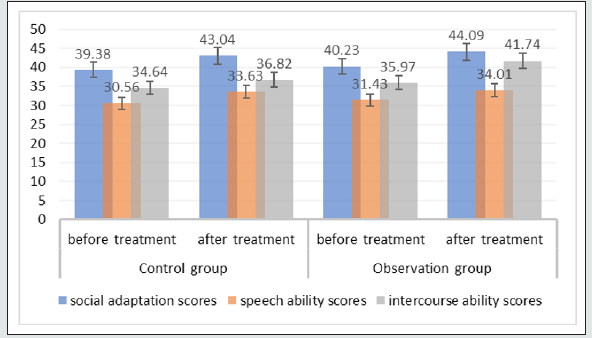
After treatment, the social adaptation, speech ability and intercourse ability scores of the observation group and the control group were improved compared with those before treatment, and the difference was statistically significant (P < 0.01), suggesting that the two methods can effectively improve the cognitive and language ability of children with autism. After treatment, there were significant differences in intercourse ability scores between the control group and the observation group (P < 0.05), suggesting that Lin’s scalp may have a special effect on improving intercourse ability. (Cited from Zhao Y et al., Shanghai J Acu-mox 2015,34(08):754-757). After treatment, the ABC scores of the observation group and the control group were lower than those of the treatment group, the difference was statistically significant (P < 0.01), suggesting that the two methods can effectively improve the core symptoms of children with autism. After treatment, the difference of ABC score between the control group and the observation group was statistically significant (P < 0.05), suggesting that Lin’s scalp may have a special effect on improving social and abnormal behavior of autistic patients. (Cited from Zhao Y et al., Shanghai J Acu-mox 2015,34(08):754-757). Jin et al. [24] investigated the therapeutic effect of interactive scalp acupuncture on autism spectrum disorder. The 83 cases of children with ASD according to the visiting sequence were randomly divided into observation group and control group, the control group using music and education therapy, the observation group using interactive scalp acupuncture therapy. Interactive scalp acupuncture therapy, that is, scalp acupuncture before the beginning of music education therapy, and music education therapy during needle retention. Scalp acupuncture group points: Zhisanzhen, Sishen, naosanzhen, mental emotional area and heart and liver area. The 0.3 mm × 25-40 mm disposable acupuncture needle was selected, and the conventional acupuncture method was used. 5 inches, and the other acupoints were 1 inch. The needle was retained for 2 hours, and the needle was twisted three times after the music education therapy training, with an interval of 15 minutes.
One time every other day, 10 times a course of treatment, 15-20 days interval, a total of 3 courses of treatment. Before treatment and after treatment were CARS, ABC and Gesell developmental quotient evaluation, continuous treatment for 3courses after evaluation of clinical efficacy of bed. The results showed that there was no significant difference in the score of cars and ABC between the observation group and the control group before treatment, indicating that they were comparable. After 3 courses of treatment, the scores of cars and ABC in the two groups showed a downward trend compared with those before treatment, and the intra group comparison was statistically significant (P < 0.01). It is concluded that the two treatment methods can improve the clinical symptoms of children with ASD. The comparison between the two groups was also statistically significant (P < 0.05), indicating that the curative effect of the observation group was better than that of the control group. (Figures 11 & 12) There was no statistical significance in DQ of social adaptation and personal social DQ between the observation group and the control group before treatment, indicating that they were comparable. After 3 courses of treatment, the social adaptation DQ and personal social DQ scores of the two groups showed an upward trend compared with those before treatment, and the intra group comparison was statistically significant (P < 0.01). These results indicate that both of the two treatments can improve the cognitive and social abilities of children with ASD. The comparison between the two groups was also statistically significant (P < 0.05), indicating that the curative effect of the observation group was better than that of the control group. (Figures 13 & 14) It can be concluded that scalp acupuncture therapy and music and education therapy combination can improve the social and cognitive function in patients with ASD, interactive scalp acupuncture treatment is better than single music education therapy. There was no mention of safety.
There was significant difference between the control group and the observation group before and after cars treatment (P < 0.01). It is suggested that both methods can improve the core symptoms of children with ASD, and the clinical effect of interactive scalp acupuncture combined with music education therapy is better than that of music education therapy. (Cited from Jin BX et al., Data collection of the 23rd National Conference on Integrated Traditional Chinese and Western medicine in pediatrics 2019:197. There was significant difference between the control group and the observation group before and after treatment (P < 0.01), suggesting that the two treatment methods can improve the core symptoms of ASD children, and the clinical effect of interactive scalp acupuncture therapy combined with music education therapy is better than music education therapy. (Cited from Jin BX et al., Data collection of the 23rd National Conference on Integrated Traditional Chinese and Western medicine in pediatrics 2019:197. The comparison between the control group and the observation group before and after social adaptation DQ treatment was statistically significant (P < 0.01), suggesting that the two treatment methods can improve the cognitive ability of children with ASD, and the clinical effect of interactive scalp acupuncture therapy combined with music education therapy is better than that of music education therapy. (Cited from Jin BX et al., Data collection of the 23rd National Conference on Integrated Traditional Chinese and Western medicine in pediatrics 2019:197. The comparison of personal social DQ between the control group and the observation group before and after treatment was statistically significant (P < 0.01), suggesting that the two treatment methods can improve the cognitive ability of children with ASD, and the clinical effect of interactive scalp acupuncture therapy combined with music education therapy is better than that of music education therapy. (Cited from Jin BX et al., Data collection of the 23rd National Conference on Integrated Traditional Chinese and Western medicine in pediatrics 2019:197.
Catgut embedding
Jin et al. [25] compared the clinical effect on the joint attention and social communication in children with ASD between the combined treatment of acupoint catgut embedding therapy with rehabilitation training and the simple application of rehabilitation training. A total of 60 children with ASD were randomized into an observation group and a control group, 30 cases in each one. In the control group, the routine ASD rehabilitation training was adopted, including conductive education, speech training and music therapy, once a day. In the observation group, on the base of the treatment as the control group, the catgut embedding therapy was applied to Shenting (GV 24), Baihui (GV 20), Shenmen (HT 7) and the optic area (the point of scalp acupuncture), once a week. In the two groups, the treatment for 4 weeks was as one course, at the interval of 1 week between the courses. A total of 3 courses of treatment were required. The social domain of the autism treatment evaluation checklist (ATEC) and the ABC were adopted to assess the therapeutic effect of the two groups. The results showed that there was no significant difference in the scores of ATEC social dimension between the two groups before treatment (P > 0.05). After treatment, the scores of ATEC social dimension in the two groups were lower than those before treatment (P < 0.01) (Figures 15 & 16), indicating that the ability of common attention and social communication of the two groups were improved after treatment. After treatment, the scores of ATEC social dimension in the observation group were lower than those in the control group (P < 0.05) (Figure17), suggesting that the improvement of common attention and social communication ability in the observation group is better than that in the control group. There was no significant difference in ABC scores between the two groups before treatment (P > 0.05).
Figure 16: Comparison of ATEC social dimension score before and after treatment in observation group.
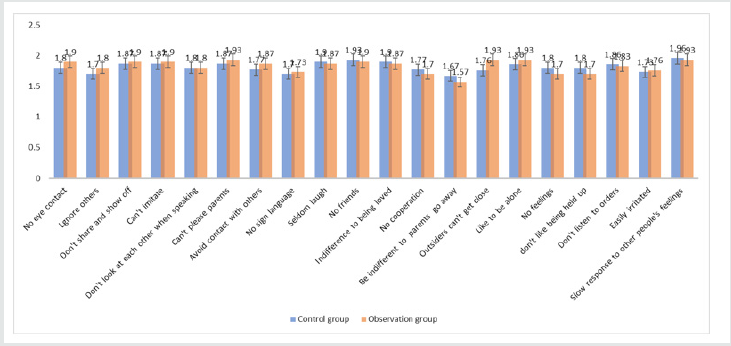
Figure 17: Comparison of ATEC social dimension score between control group and observation group after treatment.
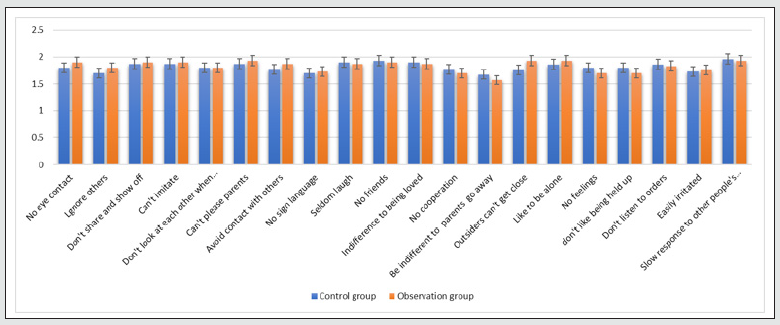
After treatment, the scores of all dimensions of ABC in the two groups were lower than those before treatment (P < 0.01) (Figures 18 & 19), indicating that the feeling, communication, body movement, language and self-care ability of both groups were improved after treatment. After treatment, the scores of all dimensions of ABC in the observation group were lower than those in the control group (P < 0.05) (Figure 20), suggesting that the improvement of ABC scores in the observation group was better than that in the control group. It can be concluded the combined treatment of acupoint catgut embedding therapy with the rehabilitation training effectively improves in the joint attention and social communication. The therapeutic effect of this combined treatment is better than the simple application of rehabilitation training. During the treatment, there were no adverse events of thread absorption and allergic events, which proved that acupoint catgut embedding has high safety. The scores of ATEC social dimension in the control group after treatment were lower than those before treatment (P < 0.01), suggesting that routine ASD rehabilitation training (guided education, speech training, music therapy) can improve the ability of common attention and social communication of ASD. (Cited from Jin BX et al., Chinese Acupuncture & Moxibustion 2020,40(02):162- 166. The scores of ATEC social dimension in the observation group after treatment were lower than those before treatment (P < 0.01), suggesting that acupoint catgut embedding therapy can improve the common attention ability and social communication ability of ASD. (Cited from Jin BX et al., Chinese Acupuncture & Moxibustion 2020,40(02):162-166. After treatment, the scores of ATEC social dimension in the observation group were lower than those in the control group (P < 0.05), suggesting that acupoint catgut embedding therapy has a positive role in promoting common attention and social communication ability of ASD children. (Cited from Jin BX et al., Chinese Acupuncture & Moxibustion 2020,40(02):162-166. The scores of each dimension of ABC in the control group after treatment were lower than those before treatment (P < 0.01), suggesting that routine ASD rehabilitation training (guided education, speech training, music therapy) can improve the sense, communication, body movement, language and life ability of ASD. (Cited from Jin BX et al., Chinese Acupuncture & Moxibustion 2020,40(02):162- 166. The scores of each dimension of ABC in the observation group after treatment were lower than those before treatment (P < 0.01), suggesting that acupoint catgut embedding therapy can improve the sense, communication, body movement, language and life ability of ASD. (Cited from Jin BX et al., Chinese Acupuncture & Moxibustion 2020,40(02):162-166. After treatment, the scores of each dimension of ABC in the observation group were lower than those in the control group (P < 0.05), suggesting that acupoint catgut embedding therapy has a positive role in promoting the sense, communication, body movement, language and life ability of ASD. (Cited from Jin BX et al., Chinese Acupuncture & Moxibustion 2020,40(02):162-166.
Figure 18: Comparison of ATEC social dimension score between control group and observation group after treatment.
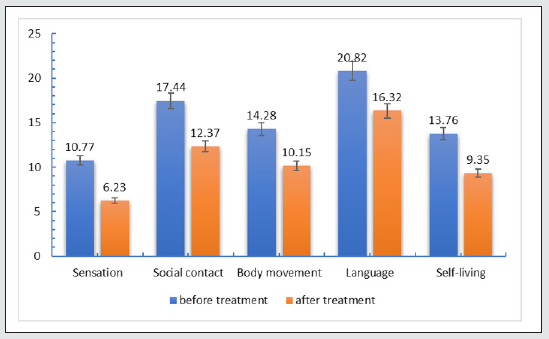
Methodological weakness
The results indicated that acupuncture was effective in the treatment of ASD. Safety result indicates safety, or no safety result is mentioned. However, the results should be explained cautiously due to methodological weakness.
a) Random sequence: Only two trials [21,25] randomly assigned participants by using a random number table. Two trials [23,24] assigned participants according to the order of the outpatient or inpatient number. One trial [19,22] did not express detailed way of random sequence generation. One trial [20] did not mention random sequence generation.
b) Allocation concealment: Only one trial [25] concealed allocation by adopting the sealed envelopes. Six trials [19-24] did not express detailed way of concealment.
c) Blinding: It is difficult to implement blinding as sham acupuncture is rarely used. Therefore, it is deemed that all trials did not blind their experimenters and subjects. In regard to the blinding of outcome evaluation, four trials [19-22] indicated that the outcomes were evaluated by a third party. Three trials [23-25] did not describe the identity of the evaluator of the outcome.
d) Incomplete outcome data: Four trials [21,22,24,25] did not have subjects excluded, withdrawn, eventually included in the analysis. Another three trials [19,20,23] did not specify the cause of subjects excluded and withdrawn.
e) Selective reporting: With regard to the selective reporting, as all trials did not register the trial protocols, there were no selective reporting.
f) Other bias: There were no other bias in all of the trials. In addition, Liu et al.. [18] did not set up a control group, so the interpretation of the research results needs to be more cautious. In order to obtain powerful evidence of the effectiveness and safety of acupuncture in the treatment of ASD, it is worth designing a study with higher methodological quality. According to the guidelines for clinical trials of acupuncture, the perfect study of acupuncture treatment for ASD is a large-sample, multi-center, double-blind, rigorously randomized, and placebo-controlled study. Detailed recording of adverse events and correct selection of statistical methods should be considered.
Potential Mechanisms of Acupuncture Therapy for Autism
The mechanism of acupuncture treatment of ASD is still unclear. Although a large number of clinical trials have proved the efficacy and safety of acupuncture in the treatment of ASD, there are few studies to reveal the mechanism of acupuncture treatment for ASD. We have found some studies on the mechanism of acupuncture in the treatment of ASD. Due to the limited sample size, lack of representativeness and design defects, it is difficult to draw consistent conclusions from these studies. Due to these defects, the potential mechanism of acupuncture treatment of ASD should be further studied on the basis of existing research.
Acupuncture affects synaptic plasticity
Synaptic plasticity plays an important role in the growth and development of the nervous system, damage repair, learning, memory and other important central nervous functions. The change of synaptic structure and function caused by mutation of candidate gene or abnormal signal pathway may be an important mechanism of autism. Current studies have shown that electroacupuncture can achieve good effects in repairing synaptic morphology of damaged neurons in autistic rats. S. Hossein Fatemi et al. [26] found that gap junctions composed of CX proteins are the structural basis of electrical synapses. The expression of CX protein was significantly abnormal in the cortex of autistic patients, which participated in the abnormal behavior process [27]. Hong Yuzhu et al. [28] found that acupuncture can regulate the expression of CX protein, thus improving the learning and memory ability of children with autism. Postsynaptic density protein 95 (PSD-95) can interact with postsynaptic amino acid receptors and play a key role in the signal transduction and integration of glutamate receptors [29]. The decreased expression of PSD-95 affects the function of synapses, which in turn affects the learning and memory functions of children with autism. Zhang Xuejun et al. [30] used electroacupuncture at Houhai acupoint to treat autism rat models and found that after acupuncture at Houhai acupoint, the expression of PSD-95 protein in the middle cortex and hippocampus of the model rats increased. By activating the BDNF-TrkB signaling pathway, it is the key to synaptic plasticity to promote the directional aggregation of PSD-95 protein from the cell body to the synapse. Neuroligin and neurexin [31,32] mainly act on nerve synapses, and the two interact and play an important role in the regulation of nerve synapses. It acts on the formation of synapse structures, or processes such as neurotransmitter release, synapse recognition, maturation and information transmission. Tero et al. [33] found that NLGN1, NLGN3, and NLGN4X are significantly related to autism. Hong Lin et al. [34] found that acupuncture at the Changqiang point of VPA autistic rats can up-regulate the expression level of NLGN3 and improve the abnormal behavior of rats. Acupuncture can repair damaged neuron synapse morphology and structure in autistic rats and affect synaptic transmission efficiency. Then directly participate in or improve synaptic plasticity, improve learning, memory, cognition and other functions, thereby treating autism.
Acupuncture regulates the release of neurotransmitters
Acupuncture can regulate the synthesis and release of various neurotransmitters in the central nervous system. It has been found that endogenous opioid peptide system may also be involved in acupuncture induced LTP process, which may be related to the improvement of learning and cognitive impairment in autism by acupuncture [35,36]. Yang Jing et al. [37] found that electroacupuncture can participate in the cerebral ischemic tolerance effect of rats by regulating endogenous opioid peptides. Modahl. C et al. [38] found that the degree of social communication dysfunction in children with autism was significantly related to the decrease of oxytocin in plasma. Lei Xuefeng et al. [39] found that electroacupuncture can regulate the release of OXT, thus playing an analgesic role. As an important neurotransmitter and its receptor, 5-HT plays an important role in the regulation of emotion, cognition, memory and learning of central nervous system. 5-HTTLPR in the promoter region of SLC6A4 of 5-HT gene encodes gene polymorphism, which increases the probability of abnormal gene transcription, thus causing abnormal 5-HT, which may be related to mental state such as neuroticism or anxiety [40]. Yu Yutian et al. [41] found that acupuncture can improve the activity of nervous system caused by abnormal 5-HT to a certain extent. Hawking et al. [42] found that electroacupuncture can improve the activity of 5-HT in hippocampus of Alzheimer’s disease model rats.
Studies have shown that there is a linkage disequilibrium relationship between glutamate gene and autism susceptibility. γ-aminobutyric acid is an amino acid transmitter that plays an important role in neurodevelopment, Warrier et al. [43] found that there is an obvious linkage imbalance between gabarb3 gene and autism, which may also be related to autism with epilepsy. The abnormality of amino acid transmitters caused by gene mutation may be related to the occurrence of autism. Acupuncture can treat autism by regulating the abnormality of amino acid transmitters. Yan Liping et al. [44] found that acupuncture prevention and treatment of epilepsy may be through g overregulating amino transmitters. Deng Yuanjiang et al. [45] found that acupuncture can prevent and treat epilepsy by affecting amino acid transmitters in hippocampus. In the above studies on autism, it is found that these neurotransmitters are involved in the occurrence and development of various human behaviors and are closely related to the pathogenesis of autism. Acupuncture can improve the symptoms of autism by regulating the release and occurrence of these neurotransmitters.
Acupuncture regulates cell apoptosis
Thompso CB et al.. used autism model rats to conduct basic research and found that the ability of neuronal cells in the brain to inhibit apoptosis was up regulated, which may be the mechanism that caused their abnormal behavior [46]. Studies have also shown that premature apoptosis of brain cells can cause encephalopathy such as Parkinson’s disease, brain atrophy, and Alzheimer’s, thereby affecting abnormal behavior [47]. Studies have shown that Bcl-2 is up-regulated, the expression of Bax and the ratio of Bax/Bcl-2 are decreased, causing abnormal hippocampal cell apoptosis, which may have an adverse effect on learning and memory [48]. Huang Qianru et al. [49] found that acupuncture at Changqiang point can improve the abnormal behavior of rats with autism. The increase of Bax protein and Bax/Bcl-2 in the hippocampus of rats and the decrease of the expression of Bel protein weaken the abnormal apoptosis ability of the hippocampus of autistic rats and regulate the abnormal development of neurons. This may be related to improving its abnormal behavior mechanism.
Acupuncture regulates cerebral blood flow
Studies have shown that SPECT examination results for children with autism show that there are focal cerebral blood flow and brain function reduction areas [50,51]. Jia Shaowei et al. [51] found that 34 children with autism had 114 different areas of cerebral blood perfusion and hypofunction through SPECT. Among them, 28 children were found to be consistent with low blood flow in the corresponding areas of children’s learning, cognitive and language dysfunction. Electro-acupuncture at the points of Hegu, Quchi, Zusanli and Sanyinjiao on both sides showed that the cerebral blood flow and brain function of the children were improved to varying degrees. The marked effect of electroacupuncture was 78.95%. It is preliminarily proved that acupuncture treatment of autism is related to improving cerebral blood flow and brain function. Whether through this mechanism or the secondary effects in the brain after acupuncture needs further study.
Acupuncture affects cytokines
Studies have found that changes in cytokines in autism play an important role in its pathogenesis, including pro-inflammatory and anti-inflammatory processes, leading to abnormal immune activation and response [52]. Among them, IL-6, IL-10, and TNFci play an important role as cytokines, especially in the aspects of neuroplasticity, behavioral programming and differentiation. Hong Wei et al. [53] confirmed that increased IL-6 levels reduced hippocampal excitement and then inhibited, and autistic rats with increased IL-6 levels showed autism-like behavior. IL-i”β” and TNFα play an important role in regulating hippocampal synaptic plasticity on the one hand, and on the other hand are also involved in the toxicity of oligodendrocytes and axon growth [54,55]. Many studies have found that acupuncture has a good effect on antiinflammatory and immune aspects. Acupuncture can inhibit and interfere with the occurrence and development of inflammation [56]. Acupuncture may protect the brain tissue by adjusting the concentration of cytokines [57].
Comments
In this part, we summarize the potential mechanism of acupuncture in the treatment of ASD. However, the mechanism of acupuncture treatment of ASD is still unclear. On the one hand, due to the complex etiology and biochemical changes of ASD, it is a neurodevelopmental disorder syndrome with a variety of biological factors. The mutation of candidate gene causes the change of transcription material, which leads to the change of neural structure, inflammatory immune response caused by cytokine imbalance, neuronal structural abnormality caused by abnormal signal pathway, apoptosis and other reasons. On the other hand, there are few basic research on the mechanism of acupuncture in the treatment of ASD. As there is no unified evaluation standard for acupuncture treatment, it is more difficult to study it. The mechanism of acupuncture is complex, but it is certain that the treatment process of ASD must be multi-channel and multi-faceted. There is reason to believe that acupuncture can potentially affect different aspects of pathology of ASD. There is still a long way to go to reveal the secret of this mechanism.
Prospective strategy: Xingnao Kaiqiao scalp acupuncture
Acupuncture has a short history in the treatment of autism, but the application of scalp points has achieved remarkable curative effect. Compared with the adverse reactions of Western medicine and complex behavior training, acupuncture and moxibustion with simple operation and no obvious adverse reactions are more easily accepted. “The head is the house of shrewdness”. “The head is the meeting of all Yang” [58]. The application of acupoints on the head can adjust the meridians and Qi of viscera, dredge meridians and coordinate the balance of yin and Yang. And scalp acupuncture can act on the corresponding functional areas of cerebral cortex. Acupuncture enhanced the stimulation of the region by twisting manipulation or electroacupuncture. It improves the cerebral blood flow perfusion of relevant regions, activates dormant nerve cells, and repairs the damaged neural network, so as to improve the cognitive and social behavior abnormalities of patients [59].
Based on this, the application of head acupoints as the main acupuncture site is more and more. There are different kinds of scalp acupuncture therapy in clinic. What we are going to introduce is “Xingnao Kaiqiao scalp acupuncture therapy”. There are 13 needles in total, including frontal five needles, Sishencong, emotional area and heart and liver area. The five acupuncture points on the forehead are Shenting point, bilateral Touwei point and bilateral Toulinqi point. Among them, Shenting is the main acupoint, and this point is mainly used to treat diseases related to mind. Sishencong, formerly known as shencong, opened 1 inch before, after, left and right of the Baihui. Because there are four acupoints, it is also known as four gods Cong. It can regulate the function of cerebral cortex and can be used to treat diseases caused by nervous and mental disorders. Except for Sishencong, the other 9 needles wiere located in the forehead, corresponding to the prefrontal lobe of the brain. Acupuncture on the scalp corresponding to the prefrontal lobe can directly stimulate the area, adjust the EEG activity, improve the cerebral blood flow velocity, and promote the functional awakening and recovery of prefrontal lobe. So it can improve intelligence, improve affective disorder, attention disorder and abnormal behavior. We have a significant effect in clinical application. However, the mechanism of “Xingnao Kaiqiao scalp acupuncture” in the treatment of ASD is rare. Therefore, we should study the mechanism of “xingnaokaiqiao scalp acupuncture” in the treatment of ASD to verify its efficacy.
Selection of duration
Study [60] have shown that electroacupuncture can improve the autonomic activity of autistic rats. Electroacupuncture for 20 seconds (15 times in total) can improve the abnormal behavior patterns of autistic rats, such as stereotyped repetition and decreased interest. Compared with normal rats, the expression of BDNF protein was down regulated and bcl-2 protein was upregulated in hippocampus of autistic rats. The expression of BDNF protein was up-regulated and the expression of Bcl-2 protein was down-regulated after 20 s electroacupuncture (15 times in total). Electroacupuncture for 20 seconds (15 times in total) can activate the expression of p-CREB and CREB protein in hippocampus of autistic rats, and cause acupuncture response effect. Whether EA 20 s (15 times in total) or 20 s (240 s in total), the stimulation time in 20s was the shortest time to take effect. Therefore, the selection of electroacupuncture duration is 20s (15 times in total).
Animal model selection
ASD is a group of neurodevelopmental disorders which have a serious impact on children’s physical and mental health. So far, its pathophysiological mechanism is not clear. With the continuous improvement of various research technologies, scientists have gradually reached a consensus that ASD is the result of interaction between genetic predisposing factors and environment. Environmental factors should not be ignored in the pathogenesis of ASD. Early embryonic development is very important for brain development. If pregnant women are infected with virus, malnutrition, contacting or taking some drugs such as sodium valproate, thalidomide or chemicals, the risk of autism in their offspring will be increased. The 12-14 days of rat embryos are equivalent to 20-24 days of human embryos, which are the key periods of neural tube closure and motor nucleus development. The incidence rate of ASD is significantly increased when the pregnant woman takes the thalidomide (20-24d) when she is pregnant. Sodium valproate is a drug for the treatment of epilepsy and bipolar depression. Taking sodium valproate in the first three months of pregnancy will lead to autistic behavior of the offspring. The above studies on the toxicity of drugs provide the basis for the experimental study of ASD and the establishment of ASD model.
Studies have shown that in E9-12.5 exposure to sodium valproate, offspring represent ASD like behaviors such as decreased social activity and increased stereotyped behavior, as well as changes in brain morphology and biochemical indicators. A large number of literatures have shown that the method of intraperitoneal injection of sodium valproate at E12.5 has good reliability and validity. It has been widely used in ASD related research and achieved ideal results. For example, in terms of behavior, the model can accurately simulate the core symptoms of ASD, such as social disorder, stereotyped repetition and so on. In terms of Neurology and molecular biology, the model is similar to autopsy reports of autistic patients. Based on the pilot study of our group and the reports of other researchers, Wistar rats were used in this study to establish the animal model of ASD by intraperitoneal injection of 600 mg / kg sodium valproate into pregnant rats at E12.5. According to roullet’s method, typical indexes were selected to test the behavior of rats induced by sodium valproate to evaluate whether the animal model was successful or not and lay a foundation for the follow-up test.
Behavioral assessments
Behavioral assessments have come to play increasingly important roles in designing experience ASD studies. Behavioral tasks are always used for verifying the success of establishing an animal model or assessing the efficacy of a new therapy. As a behavioral test should have the following features: (1) objectivity and repeatability; (2) quantitative; (3) representativeness; (4) operability; and (5) sensitivity.
Three box experiments
Social intercourse refers to the communication between people in the society. It is a kind of social activities in which people transmit information and exchange ideas to achieve certain goals. The mechanism of social behavior is a complex process, which acts on a variety of sensory organs through the stimulation of internal and external environment, resulting in the corresponding behavior of individuals to the stimulation. Human beings can integrate themselves into this society through the interaction between human beings. For many animals, social interaction is equally important. Social disorder is a manifestation of depression and autism. In order to study the changes of social behavior in animal models, scientists have developed a series of social behavior experiments, among which the more mature is the “three box social test” for rats and mice. The principle is based on the natural gregarious nature of wild mice and the tendency to explore new things. Wild type mice are social animals, they have certain social attributes. When they contact with the same kind, they can form a certain social memory. This social memory can further influence their social decisions. Therefore, when faced with new and unfamiliar individuals, normal rats will recall the same kind of memory that they have contacted and are familiar with before. For them, the novelty of the same species is more alluring. Therefore, in the face of familiar and completely unfamiliar siblings, normal rats are willing to contact with strangers for a longer time, showing social desire and novelty preference. Early exposure to sodium valproate in rats leads to nervous system development disorders, decreased desire for novelty exploration, and loss of social desire and novelty preference.
Open field experiment
Rodents have the characteristics of pursuing advantages and avoiding harm. Animals will be very careful in an open new place. Animals like dark and avoid light, which makes them hide in the corner, and easily do not step into the central grid. However, they will also explore the open space (curiosity). It has certain novelty and certain fear at the same time. In open field experiments, they tend to stay in the corner or edge against the wall, and they also have the nature to explore new environment. They tend to stay in the center and have more distance to move. Open field experiments are often used to evaluate the depression and anxiety of animals. Depression animal models showed that they spent more time in the corner and edge. On the contrary, anxious animals run more, have more activities, spend more time in the center. The central grid residence time can also be used to evaluate the anxiety level of animals. Autistic children will generally show abnormal emotional problems, manifesting irritability, irritability, hyperactivity, rigid, do not like to change and new things. Autism rats often have the characteristics of abnormal mood, aggressive behavior, large amount of activity and hyperactivity, which are the manifestations of stress and anxiety.
Morris water maze
The camera system installed on the top of the maze mainly monitors the spatial learning and memory ability and memory maintenance time of animals, which can quantify learning and memory. In the positioning cruise experiment, the spatial learning and memory ability was evaluated by recording the time of escaping from lurking on the hidden platform. The prolongation of escape latency indicates the decline of learning and memory ability. In the space exploration experiment, the number of times that animals cross the original platform position in a specified time reflects their ability to maintain spatial memory.
Concluding Remarks
In this chapter, we have summarized the clinical application of acupuncture in the treatment of ASD by reviewing current studies and try to find the potential mechanism from the limited information available. Many studies have reported positive efficacy and fewer side effects of acupuncture in the treatment of ASD. Some studies focusing on the underlying mechanism of acupuncture are under way. If the effect of acupuncture is strictly verified, acupuncture will be introduced to the mainstream academic theory as an alternative therapy commonly used in the treatment of ASD. Like other alternative therapies, the efficacy and safety of acupuncture have not been rigorously verified. Due to methodological defects, the observation and results thus obtained have overestimated the treatment efficacy and concealed the possible adverse events, which reduces the reliability of these studies. This is the main reason why some alternative therapies are not accepted. What is worse is that not only is the therapy itself under doubt, but it has prejudiced the viewpoint of the involved researchers against the whole TCM theory system, including those from its motherland. It is for this reason that TCM today faces an awkward stand even in China. So, we wish to raise these interests and bring forth the need for well-designed, rigorous clinical and experimental studies to provide formidable scientific evidence validating the efficacy and safety of acupuncture in the treatment of ASD. At the end of this chapter, we put forward “Xingnao Kaiqiao scalp acupuncture therapy” We believe it will be accepted by most ASD researchers, including general medical surveys.
References
- Siniscalco D, Bradstreet JJ, Antonucci N (2012) The promise of regenerative medicine and stemcell research for the treatment of autism. J Regen Med 1: 1.
- (2000) American Psychiatric Association. Diagnostic and Statistical Manual of Mental Disorders, TextRrevision, 4th ed. Washington: American Psychiatric Press, USA.
- Liu ZH, Xie QL, Lin QM (2013) Quality of life of autistic children and its influencing factors. Chin J Appl Clin Pediatr (12): 902-904.
- Liu ZH, Xie QL, Zhao Y (2013) Study on the quality of life of parents of autistic children. Chin J Child Heal Care, 21(04): 433-435.
- Burd L, Fisher W, Kerbeshian J (1987) A prevalence study of pervasive developmental disorders in North Dakota. Journal of American Academy of Child and Adolescent Psychiatry 26(5): 700-703.
- Baird G, Simonoff E, Pickles A, Susie Chandler, et al. (2006) Prevalence of disorders of the autism spectrum in a population cohort of children in South Thames: the Special Needs and Autism Project (SNAP). Lancet 368(9531): 210-5.
- Jon Baio, (2012) Eds. Prevalence of autism spectrum disorders-autism and developmental disabilities monitoring network, 14sites, United states,2008[J]. MMWR SurveiU Summ ,61(3): 1-19.
- (2017) World Health Organization (WHO). Autism spectrum disorders: Fact sheet.
- Chauhan A, Chauhan V (2006) Oxidative stress in autism. Pathophysiology 13(3): 171-181.
- Bryson SE, Rogers SJ, Fombonne E (2003) autism spectrum disorders: early detection, intervention, education, and psychopharmacological management. Canadian Journal of Psychiatry 48(8): 506-516.
- Myers SM, Johnson CP (2007) Management of children with autism spectrum disorders. Pediatrics 120: 1162-1182.
- McVoy M, Findling RL (2009) Child and adolescent psychopharmacology update. Psychiatr Clin North Am 32: 111-33.
- McCrackenJT, McGoughJ, ShahB, Pegeen Cronin, Daniel Hong et al. (2002) Risperidone in children with autism and serious behavioral problems. N Engl J Med 347(5): 314-321.
- Hanson E, Kalish LA, Bunce E, Christine Curtis, Samuel McDaniel et al. (2007) Use of complementary and alternative medicine among children diagnosed with autism spectrum disorder. J Autism Dev Disord 37(4): 628-636.
- Levy SE, Hyman SL (2015) Complementary and alternative medicine treatments for children with autism spectrum disorders. Child Adolesc Psychiatr Clin N Am 24(1): 117-143.
- Warren LR, Rao PA, Paton DC (2017) A pilot observational study of an acupressure/acupuncture intervention in children with autism spectrum disorder. J Altern Complement Med 23: 844-851.
- Lee B, Lee J, Cheon JH, Hyun-Kyung Sung , Seung-Hun Cho, et al. (2018) The efficacy and safety of acupuncture for the treatment of children with autism spectrum disorder: a systematic review and meta-analysis. Evid Based Complement Alternat Med 2018: 1057539.
- Liu ZH, Zhang HY, Zhang CT (2009) Observations on the Therapeutic Effect of Scalp Acupuncture on Infantile Autism. Shanghai J Acu-mox, 28(11): 637-638.
- Liu ZH, Li N. Music therapy combined with scalp acupuncture in the treatment of autism[C]. Proceedings of the 10th Annual Academic Meeting of China Music Therapy Association 2011: 56-62.
- Li N, Jin BX, Li JL, Zhen-huan Liu (2011) Treatment of autism with scalp acupuncture[J]. Chinese Acupuncture & Moxibustion 31(08): 692-696.
- Li N, Liu ZH (2011) Clinical study on the treatment of autistic disorder with scalp acupuncture. Collection of materials and papers of the 8th National Academic Conference on rehabilitation therapy of Chinese Association of rehabilitation medicine 2011: 121-122.
- Li N, Liu ZH (2013) Children's music therapy combined with acupuncture and massage on the behavior and psychological rehabilitation of autistic children.2013 annual academic meeting of Chinese society of acupuncture and moxibustion the 4th International Conference on modernization of traditional Chinese Medicine 2013: 311-313.
- Zhao Y, Jin BX, Liu ZH (2015) Clinical Study on Needling LIN’s Three Temporal Acupoints for Children with Autism. Shanghai J Acumox 34(8): 754-757.
- Jin BX, Zhao Y, Liu ZH (2019) Observation of the Effect of Interactive Scalp Acupuncture in Treating Autism Spectrum Disorder. Data collection of the 23rd National Conference on Integrated Traditional Chinese and Western medicine in pediatrics 2019: 197.
- Jin BX, Li N, Zhao Y, Xu-Guang Qian, Zhen-Huan Liu, et al. (2020) Effect of acupoint catgut embedding therapy on joint attention and social communication in children with autism spectrum disorder: a randomized controlled trial. Chinese Acupuncture & Moxibustion, 40(2): 162-166.
- S Hossein Fatemi MD, Timothy D Folsom, Teri J Reutiman, Susanne Lee (2008) Expression of astrocytic markers aquaporin 4 and connexin 43 is altered in brains of subjects with autism. Synapse 62(7): 501-507.
- Sun XL (2012) Research progress of electrical synaptic function in mammalian nervous system[J]. Shandong medical journal, 52(46): 97-99.
- Hong YZ (2014) Expression of gap junction associated protein in prefrontal cortex of autistic rats and intervention of acupuncture at Changqiang. Fujian University of traditional Chinese Medicine.
- Qi J, Hou XY (2007) PSD-95 and neuropsychiatric diseases. Advances in physiological science 38(2): 171-173.
- Zhang XJ, Hong L, Hou XY (2013) Effect of acupuncture at Houhai point on PSD-95 protein expression in M1 area of cerebral cortex and CA1 area of hippocampus in autistic rats. Journal of Fujian University of traditional Chinese Medicine 23(3): 15-17.
- Scheiffele P, Fan J, Choih J, R Fetter, T Serafini et al. (2000) Neuroligin expressed in nonneuronal cells triggers presynaptic development in contacting axons. Cell 101(6): 657-69.
- Sudhof TC (2008) Neuroligins and neurexins link synaptic function to cognitive disease. Nature 455: 903-911.
- Ylisaukko-Oja T, Rehnstrom K, Auranen M, Raija Vanhala, Reija Alen, et al. (2005) Analysis of four neuroligin genes as candidates for autism. European Journal of Human Genetics Ejhg 13(12): 1285-92.
- Hong L (2014) Effect of acupuncture at Changqiang on nlgn-3 protein expression in hippocampus of autistic rats[D]. Fujian University of traditional Chinese Medicine.
- Zeng Y, Liang XC, Li M (2004) Effect of Electroacupuncture on behavioral abnormality and long-term potentiation of hippocampal CA3 in morphine withdrawal rats. Acupuncture research 29(4): 245-251.
- Ma C, Yan LP, Shen MH (2003) Effect of Electroacupuncture on long term potentiation of excitatory postsynaptic potential in rat hippocampus[J]. Journal of Nanjing University of traditional Chinese Medicine 8(03): 2587-2589.
- Yang J (2004) Effect of electroacupuncture moxibustion preconditioning on cerebral ischemic tolerance in rats and its mechanism [D]. The Fourth Military Medical University p. 58.
- Modahl C, Fein D, Waterhouse L (1992) Does oxytocin deficiency mediate social deficits inautism. Autism Dev Disord 22(3): 449-451.
- Lei XF, Liu WY (2005) Is oxytocin and endogenous opioid peptide synergetic in the process of electroacupuncture analgesia. Chinese Journal of clinical rehabilitation (24): 112-113.
- Tassone F, Qi L, Zhang W, Robin L Hansen, Isaac N Pessah et al. (2011) MAOA, DBH, and SLC6A4 variants in CHARLIE: a case-control study of autism spectrum. Autism Res 4(4): 250-261.
- Yu YT, Yuan Q, Chen JY (2015) Effect of acupuncture combined with medicine on behavior and 5-HT receptor mRNA expression in dorsal raphe nucleus of depression rats with sleep disorder[J]. Journal of Guangzhou University of traditional Chinese Medicine 32(03).
- Huo J, Han S (2012) Effect of Electroacupuncture on 5-HT and chat mRNA in Alzheimer's disease rats. Journal of Clinical Acupuncture and Moxibustion 28(04): 68-70.
- Warrier V, Baron-Cohen S, Chakrabarti B (2013) Genetic variation in GABRB3 is associated with sparger syndrome and multiple endophenotype relevant to autism. Mol Autism 4(1): 48-58.
- Yan LP, Li JJ (1999) Effect of acupuncture on the contents of GABA and Glu in brainstem of rats with experimental acute epilepsy[J]. Chinese Acupuncture & Moxibustion (04): 3-5.
- Deng YJ, Liu WY, Liang WX (2006) Effect of acupuncture on electroencephalogram power and amino acid transmitters in hippocampus of rats with acute epilepsy. Journal of Guangzhou University of traditional Chinese Medicine (06): 509-512.
- Thompso CB (1995) Apoptosisinthe pathogenesis treatment of disease. Science 267(5203): 1456-1462.
- Zhang XJ, Hong L, Hong YZ (2013) Effect of electroacupuncture at Houhai on learning and memory ability of autistic rats. Journal of Fujian University of traditional Chinese medicine 23(01): 13-15.
- Wang Y (2008) Effects of hippocampal neuronal apoptosis on learning and memory in rats with different exercise models. East China Normal University, China.
- Huang QR (2015) Expression of apoptosis related proteins in hippocampus of autistic rats and intervention effect of electroacupuncture at "Changqiang". Fujian University of traditional Chinese medicine.
- Shu MY, Jia SW, Zhang FX (2001) Single photon emission computed tomography in children with autism. Chinese Journal of Psychiatry (02): 15-18.
- Jia SW, Sun TT, Fan R (2008) Visualization of single photon emission computed tomography in the treatment of childhood autism with Acupuncture. Chinese Journal of Integrated Chinese and Western Medicine 2008(10): 886-889.
- Zhang LP (2013) Study on the relationship between cytokines and autism. Jilin University, China 2013: 7.
- Wei H, Chadman KK, Mccloskey DP, Ashfaq M Sheikh, Mazhar Malik, et al. (2012) Brain IL-6 elevation causes neuronal circuitry imbalances and mediates autism-like behavious. Biochim Biophys Acta 1822(6): 831-842.
- Baeker V, Middleton G, Davery F, A M Davies et al. (2001) TNFalpha contribution to the death of NGF-dependent neurons during development[J]. Nature Neuroscience 4(12): 1194-1198.
- Emanuele Cacci, Maria Antonietta Ajmone-Cat, et al. (2008) In vitro, neuronal and glial differentiation from embryonic or adult neural precursor cells are differently affected by chronic or acute activation of microglia. Glia 56(4): 412-425.
- Huo ZJ, Zhang Li, Qian RQ (2003) Effects of acupuncture at different acupoints on TNF-α, IL-6, WBC and free radicals in rats with global cerebral ischemia-reperfusion. Acupuncture research 2003(02): 94-98+123.
- Zhang YM, Chen SH, Sun H (2013) Effect of acupuncture on the expression of IL-1 β and IL-6 in peripheral serum of rats with cerebral ischemia-reperfusion injury[J]. Journal of Clinical Acupuncture and Moxibustion 29(01): 60-63.
- Ren YD (1989) On the head is the meeting of all Yang. Xinjiang Journal of Traditional Chinese Medicine (3): 46-47.
- Wang HL (2010) Lin's scalp acupuncture in the treatment of 11 children with autism. Fujian traditional Chinese Medicine 41(3): 39-42.
- Lin S (2020) Effect of Electroacupuncture with different duration on bdnfcreb related signal pathway in autistic rats. Fujian University of traditional Chinese Medicine, China.

Top Editors
-

Mark E Smith
Bio chemistry
University of Texas Medical Branch, USA -

Lawrence A Presley
Department of Criminal Justice
Liberty University, USA -

Thomas W Miller
Department of Psychiatry
University of Kentucky, USA -

Gjumrakch Aliev
Department of Medicine
Gally International Biomedical Research & Consulting LLC, USA -

Christopher Bryant
Department of Urbanisation and Agricultural
Montreal university, USA -

Robert William Frare
Oral & Maxillofacial Pathology
New York University, USA -

Rudolph Modesto Navari
Gastroenterology and Hepatology
University of Alabama, UK -

Andrew Hague
Department of Medicine
Universities of Bradford, UK -

George Gregory Buttigieg
Maltese College of Obstetrics and Gynaecology, Europe -

Chen-Hsiung Yeh
Oncology
Circulogene Theranostics, England -
.png)
Emilio Bucio-Carrillo
Radiation Chemistry
National University of Mexico, USA -
.jpg)
Casey J Grenier
Analytical Chemistry
Wentworth Institute of Technology, USA -
Hany Atalah
Minimally Invasive Surgery
Mercer University school of Medicine, USA -

Abu-Hussein Muhamad
Pediatric Dentistry
University of Athens , Greece

The annual scholar awards from Lupine Publishers honor a selected number Read More...




